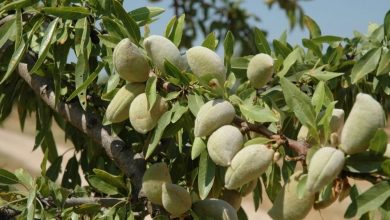San Pedro Cactus: [Planting, Care, Substrate, Irrigation]
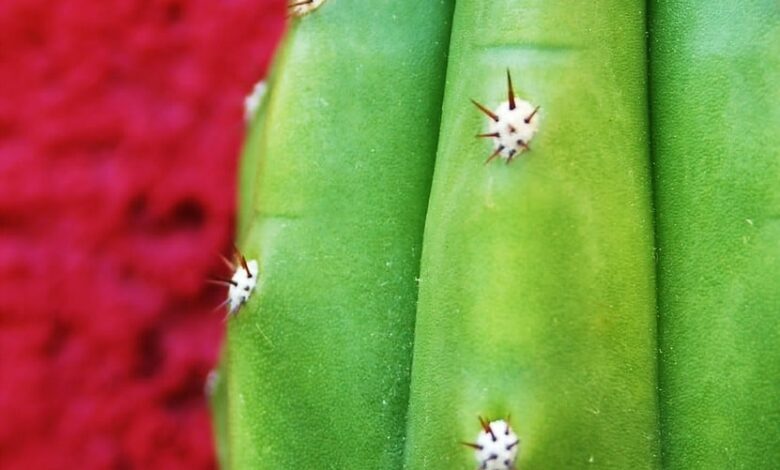
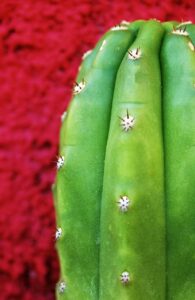 The San Pedro Cactus, with the scientific name Trichocereus pachanoi, genus Echinopsis and family Cactaceae, is a native plant of the Andean Cordillera, where it is capable of growing at an altitude of up to 3,000 meters above sea level.
The San Pedro Cactus, with the scientific name Trichocereus pachanoi, genus Echinopsis and family Cactaceae, is a native plant of the Andean Cordillera, where it is capable of growing at an altitude of up to 3,000 meters above sea level.
It lives in Ecuador, Bolivia, Peru, Argentina and Chile, but the fame of its beautiful flower has moved it to very distant latitudes of the American continent.
It is not difficult to grow it in a pot, where it grows fast until it reaches a maximum of 4 meters with the best care. This columnar type cactus adapts to everything, thanks to its superficial roots that are about 30 cm thick.
It is also an excellent houseplant and can serve as a decorative plant . It also has medicinal uses .
Characteristics of the San Pedro cactus
Its trunk is green, but with various shades that go from dark to light. Crossed by white halos along its ribs, it produces about 7 yellow or brown spines , which grow up to 2 cm.
In ideal conditions, it can reach up to 6 meters in height outdoors .
 It also produces a dark green fruit about 5 cm long and the flower, truly beautiful, emits a delicate aroma, but the most curious thing is that it closes during the day and opens at night. They can measure up to 23 cm in length.
It also produces a dark green fruit about 5 cm long and the flower, truly beautiful, emits a delicate aroma, but the most curious thing is that it closes during the day and opens at night. They can measure up to 23 cm in length.
Three thousand years ago, this cactus was one of the epicenters of the religious activities of the American aboriginal ethnic groups, especially in Peru, where they used to cut the trunk to boil the slices obtained.
Already cold, the natives drank this hallucinogenic brew in rituals.
This happens due to the highly alkaline composition of the San Pedro cactus. It is a powerful hallucinogen. The causes of this property are the following substances: Tyramine, 3-Methoxytyramine, Hordinenine and mixturelin.
But although it is a cactus that gives little work, in places far from its original climate it can get sick to the point of rot, so these tips will go a long way to avoid it and to live many years in any corner of your home.
It has been used for centuries by indigenous tribes. The name of San Pedro comes to him because the first colonizers, when taking it, claimed to visit heaven and San Pedro.
Amazing, right?
Temperature: Where to plant a San Pedro cactus?
Originally, it lives in very hot areas of northern Peru and southern Ecuador. This means that exposing it to a freezing temperature or winter frosts typical of Europe, will cause forceful damage. Therefore, we do not advise you to allow a drop in temperature below 5 ° C.
It supports hot climates and mild winters, where the care related to sunlight and irrigation will be fine-tuned.
The ideal is to keep it in temperatures between 20 to 30 ° C.
Light: What light needs do you have?
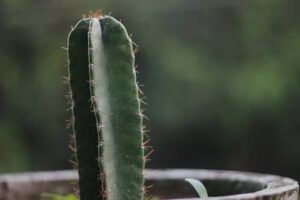 Receiving the sun directly for several hours a day will strengthen you, because it assimilates vitamins and nutrients that you need so much to grow. So the location at home has to take into account this prevailing factor of intense natural lighting.
Receiving the sun directly for several hours a day will strengthen you, because it assimilates vitamins and nutrients that you need so much to grow. So the location at home has to take into account this prevailing factor of intense natural lighting.
Substrate and Compost: How do we prepare the soil?
The potted cactus does not register major difficulties because it has shallow roots. The important thing at this point is that the pot has a good drainage system, which is guaranteed with permeable soil.
A good way to plant it would be under a combination of the substrate between peat and perlite.
The transplant should occur every two years. A larger pot will allow it to get stronger and grow even more. Do it in spring .
The best thing, if you want to avoid complications, is that you ask your trusted store for a specific fertilizer for cacti.
In the event that you dare to cultivate it from seeds , you must create a soil mixture rich in: 50% soil; 20% sand; another 20% pebbles and 10% perlite.
Planting the San Pedro cactus step by step
- It starts in early spring. Mix equal parts sterile perlite, vermiculite, and peat. Use a mixing surface that has been cleaned with a 10 percent bleach solution to kill any plant pathogens.
- Clean a 4-inch plastic bottle with 10 percent bleach solution. Fill it to 1/4 of the pot from the rim of the pot with the potting mix. Tap the pot gently to set the mixture so that there is about halfway between the top of the soil and the rim of the pot; the ground must be level.
- Put the filled pot in a clean, shallow 6-inch pan of water. Wait until the water is soaked and the top of the soil is wet. Remove the pot from the water and let it drain.
- Scatter the seeds as evenly as possible over the surface of the soil in the pot. Cover the soil with a single, loose layer of fine chicken sand to support the seedlings as they grow.
- Lightly mist the grit with the water bottle. Cover the pot with clear plastic wrap or a 4-inch-square sheet of acrylic plastic.
Irrigation: How and how often do we water?
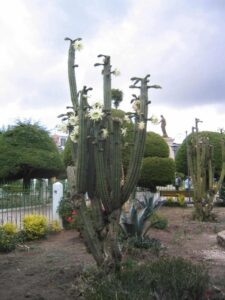 Every cactus stores enough water, a property that allows it to withstand living in inhospitable places. Remember that it comes from dry environments. Changing his life will bring serious problems for his development.
Every cactus stores enough water, a property that allows it to withstand living in inhospitable places. Remember that it comes from dry environments. Changing his life will bring serious problems for his development.
The winter , as always is wetter, requires watering only once a month. Doing the opposite will saturate the plant with water until it rottes and dies.
For the rest, the Cactus San Pedro will be satisfied with receiving water in moderate quantity every 20 days.
But the most important thing about its maintenance is never over watering the San Pedro Cactus .
Transplanting or changing to a larger pot is good to do every two years in the spring. This will stimulate progressive growth and good health.
The San Pedro cactus is a true gift that you can have in any room in your home. He only asks in return for a very bright place and very controlled irrigation.
Dare to grow it and it will be your luxury guest for many years.

